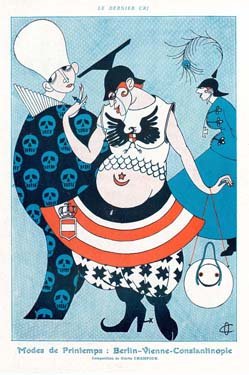Fashioning the War
French fashion, an important industry, became a strong symbolic tool to assert the power and predominance of Gallic culture and to differenti-ate the French from their enemies. Fashion illustrators, largely unemployed by this business for the duration of the conflict, turned their talents to supporting the war effort in a variety of venues.
Rare Book Collection, Gift of Neil Harris and Teri J. Edelstein
Odette Champion depicted the spring fashions in Berlin, Vienna, and Constantinople. "Le dernier cri" of the Axis would not pass muster in Paris. The physique and style of the breast-plated Prussian model are grotesque. Even additions of an upside-down pyramid or a peacock feather cannot make the pickelhaube helmet fashionable. The Viennese designs seem inspired by Gustav Klimt, albeit with a motif of skulls. Although not specifically a fashion magazine, Fantasio employed many fashion illustrators who commented on the war with illustrations approximating fashion plates.
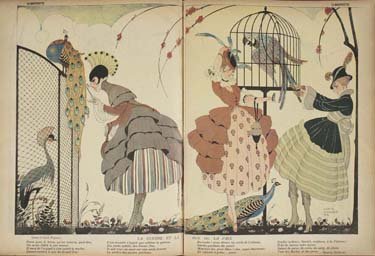
Gerda Wegener, Modes de Guerre, La Baïonnette 20 avril 1916
Rare Book Collection
Issue six of La baïonnette, "Elégances berlinoises," was the first to focus exclusively on fashion, and throughout the years a number of issues were devoted to this topic. But women in every issue were suffused with the modishness of the mannequin, not surprisingly since many illustrators had previously worked for fashion magazines. The Danish illustrator Gerda Wegener, who had begun working for Vogue in 1912, was a featured contributor. Her cover on national dress offered an opportunity to show off her highly detailed, delicately colored, curvilinear style contrasting French fashion through the ages with wartime austerity.
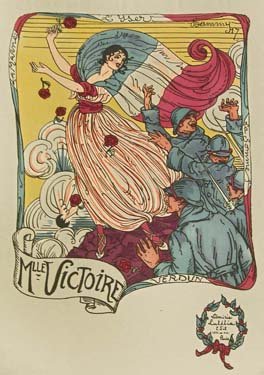
On loan from Brown University Library, Anne S.K. Brown Military Collection
A comely and fashionably dressed young woman, Mlle Victoire scatters red roses leading a group of poilus, the tricolore fluttering behind. In the border are the names of battles: La Marne, Verdun, La Somme, L'Yser. Clearly all were deemed victories of the war from 1914 to 1916. In the battle of the Somme alone, which lasted five months in 1916, more than one million men are believed to have died or been wounded, more than half on the Allied side. This print was one of the many messages aimed at keeping soldiers and the home front committed to the cause.
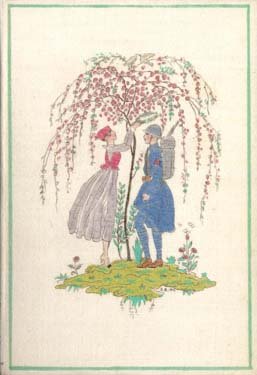
On loan from a private collection
In 1917, the first year of five, the delicate silk cover of La guirlande des mois featured an elegant young woman crowning a French infantryman with a laurel wreath beneath a weeping cherry tree. Two doves perch on the topmost branches. It is a trope of love dominating both victory and suffering. Inside, an arresting illustration, "En avant!," shows soldiers hurling grenades through a black night, lit by the showers of sparks and bright yellow lights of explosions. The covers and interior illustrations of this almanac frequently allude to the conflict.
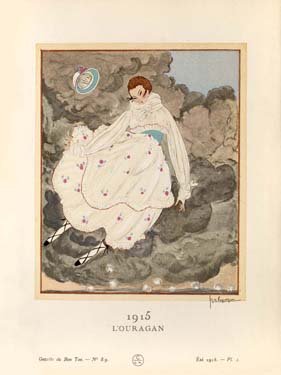
On loan from the Art Institute of Chicago, Ryerson & Burnham Libraries
Image courtesy of Ryerson and Burnham Libraries, Art Institute of Chicago; ©2014 Artists Rights Society (ARS), New York/ADAGP, Paris
From the beginning Georges Lepape was one of the most radical and prolific contributors to Lucien Vogel's fashion magazine, Gazette du bon ton. His brilliant use of unusual color and essential simplification of form were immediately recognizable. In August 1914 a skirt depicted by Lepape featured a design reminiscent of the cocarde. By the summer of 1915, in this illustration the landscape, a white billowing dress, even the blue and red circle of the cocarde were being blown apart by the explosions surrounding the woman—a hurricane, the caption declares.
